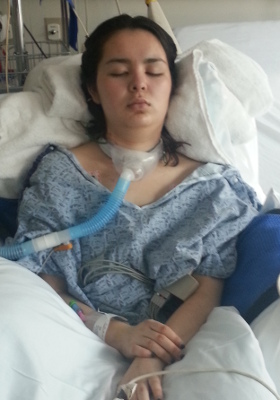Standing around Taylor’s room all night checking out the equipment caused some awareness of the big picture of consciousness recovery. Here are the basics of consciousness recovery:
Intubation – is inserting a breathing tube in the mouth that has two functions. First, it allows easy hookup to a breathing machine which may be needed if the unconscious patient can’t breath on their own. Second, it has a balloon mid tube that is inflated to help block the airway to prevent fluid from seeping into the lungs. The balloon also keeps air forced into the lungs from going up into the mouth and sinus.
Ventalator – This is a programmable breathing machine that helps patients breathe. It has two main modes. Fully regulated breathing mode pushes air into the lungs at a specified rate and duration. Assisted breathing mode detects the patient’s breathing and assists by adding air when the patient inhales.
Sedation – is needed for two reasons. First it prevents patients from having continued gag responses caused by the intubation. Secondly it prevents patient initiated breathing from fighting the ventalator. Fighting the ventalator occurs when the patient is not able to initiate their own breaths in an effective way, either by breathing too short and shallow or to big and long when the body needs steady full breaths.
Catch 22
Because the patient is unconscious they are intubated and placed on a ventelator, which causes the need for sedation, which renders the patient unconscious. How are they ever supposed to become conscious if they are always sedated?
The clinical answer to this question, currently in practice with Taylor, is they are taken off sedation each day to see if they wake up. However this method makes a few assumptions that may not or may not be true on a case by case basis.
It assumes the patient is going to wake up quickly after the sedative is removed. Typically a patient is taken off sedation for less than an hour while a neurological test if performed. This means the patient is sedated 95+ percent of the time. If a patient is slow to wake, for instance if they take several hours to slowly come to consciousness, then this method won’t get to that point.
It also assumes the patient is not harmed by the sedative while their neurological system is healing. The assumption is that because the sedative does not show any neurological side effects in patients with normal brain function then it should have no effect on patients with healing brain functions.
Tracheostomy To the Rescue
The situation described above applies for patients who don’t wake up after the first one to two weeks. After that point a Tracheostomy comes to the rescue by taking the tube out of the mouth and into the windpipe through the front of the neck. Taylor is scheduled for one of these tomorrow (3/2/2014). This allows the patient to come off the sedative as it’s much more comfortable for the patient than intubation. The challenge is that by this time the patient’s neurological healing has mostly taken place.
Products That Would Help
Blood Oxygenater – To help this situation it would be great to have an alternative way to oxygenate blood. If a magic box cold be placed next to Taylor that would supplement her lungs ability to oxygenate her blood… that would be great.
Throat Clearer – to avoid pneumonia caused by fluids entering the windpipe it would be great to have a light weight soft device that would sit in the throat comfortably and clear any fluids before they enter the lungs.
Although these products may sound far fetched and I don’t have any idea how to make them, I am sure someday they will exist. Doctors and Nurses today are completely comfortable with days and even weeks long sedation for recovering patients, but someday we may look back and wonder how long term sedation to help recover consciousness ever made sense.

